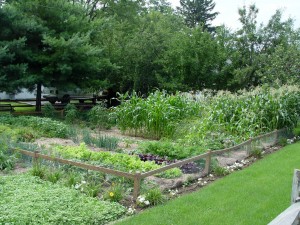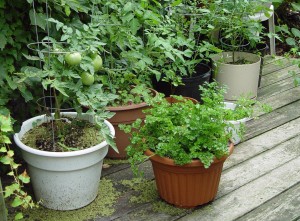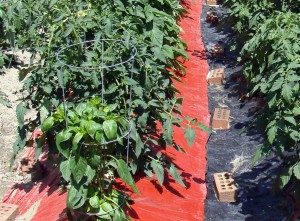Grow Vegetables in the Shade? It’s Possible…
May 2nd, 2014
One of the first pointers new veggie gardeners run into is, “Pick a sunny spot.”
But what if you don’t have a sunny spot?
What if your yard is filled with trees?
What if the only open or doable space happens to be in a limited-light eastern or northern exposure?
You might not win any big-tomato contests in those spots, but neither does lack of a full-sun spot mean your hope of growing food is dashed.
A fair number of edibles do reasonably well with just 4 or 5 hours of sun a day.
Most leafy crops yield a decent return with less than that – even delaying their “bolt” to the bitter-tasting seed-producing stage out of summer’s approaching peak sunlight.
By coaxing what light you do have to the maximum, it’s possible to grow a respectable range of home-grown crops.
If your yard is light-challenged, a good starting point is to analyze exactly which spots get light when.
Even slight shifts in garden placement can add an extra hour or two of sunlight – possibly the difference between a pepper that fruits and one that’s little more than a foliage plant.
You might be surprised that some possible garden spots get more light than you thought. A cheap light meter – available in garden catalogs and some garden centers – can help you zero in on candidate sites.
Second, if you’re not sure what crops might work in a spot you’re considering, do a pot trial.
Before digging the ground or installing raised-bed boxes, try growing a few crops you like in pots in that site.
If they get leggy or fail to produce, try another spot.
While you’re growing in pots, consider that that approach may be your answer itself.
Crops in pots are portable enough to be moved, especially if you place them on casters or a wheeled platform. That lets you move the pots to capture what sun you can as the season’s light changes.
For example, grow potted lettuce in spring under trees before the trees fully leaf out. Then harvest the lettuce and replant with a compact tomato after moving the pot to a sunnier deck in summer when the trees are producing dense shade.
A third strategy is altering the light that’s reaching the ground under and near trees.
Thinning out tree canopies (i.e. removing selected branches) might create enough dappled sunlight to support part-shade edibles underneath.
Removing some of the tree’s lowest limbs (“limbing up”) also may let in lots of new light.
That’s an especially good solution if you’re thinking about planting an edible garden on the south side of your trees. In our latitude, the sun’s angle comes in from the south and often pokes in under trees that have been limbed up to 6 or 8 feet.
Something else to take into consideration around trees… the roots.
Sometimes, competition from moisture- and nutrient-sucking tree roots is more of a problem than the shade from the tree leaves.
Species such as beech, oak, walnut, honeylocust, sweetgum, tulip poplar, willow and most maples are especially tough competitors due to their big and close-to-the-surface root structures.
To get around the root issue, you’ve got three good options:
1.) Grow in pots set on the stone-, bark- or wood-mulched tree bed (no more than 3 or 4 inches of mulch).
2.) Sink several large and fairly shallow pots among the tree roots. This keeps the tree roots out of the growing medium and reduces the watering that’s needed in above-ground pots. Make sure your pots have ample holes in the bottom for drainage.
3.) Place raised-bed boxes over the tree-root bed and line the bottom with carpet, weed fabric or thick plastic to keep the tree roots from growing up into the boxes.
Another shade-growing strategy is to boost your limited light via reflection.
If you’ve got a fence or wall behind the garden, paint it white or a light color. If you’re adding a backdrop, make it a light one.
Better yet, mulch the ground around your plants with a light reflective material.
Aluminum foil is one good homemade option that also gives you weed control.
Or invest in a roll of plastic reflective mulch that’s made specifically for gardening.
Lean toward white or silver colors in shade, but experiment with other colors that are available in many seed and garden catalogs.
Red mulch, for example, has been found to boost the yield of tomatoes, while silver mulch also repels some insects. (Sources include: Johnny’s Selected Seeds, Territorial Seed Co., David’s Garden Seeds through Amazon.com., and Harris Seeds.)
Finally, go with crops that are best adapted to producing with less than 6 hours of direct sun per day.
Root crops are fairly efficient in just 4 or 5 hours of light. These include radishes, parsnips, beets, leeks, onions (especially scallions), shallots, turnips, rutabagas and maybe even potatoes.
Half-day light also is often enough to grow asparagus, rhubarb, basil, beans, peas, celery, broccoli, cauliflower, cabbage, kohlrabi, carrots and Brussels sprouts.
Some bush fruits produce in part shade as well, such as blackberry, raspberry, chokeberry, gooseberry, currant, hardy kiwi, low-bush blueberry and alpine strawberry.
If your light is too low to support even those, look to the leafers instead of crops that need light to flower and fruit.
This category includes all of the lettuces (especially leaf lettuces) as well as endive, kale, chard, collards, mesclun, pak choi, mustard, arugula, spinach and most herbs (chervil, chives, dill, tarragon, parsley and lovage, for example).
It’s a worth a try. Don’t let a little shade discourage you.
If nothing else, at least you won’t end up sun-burned in addition to hungry.










